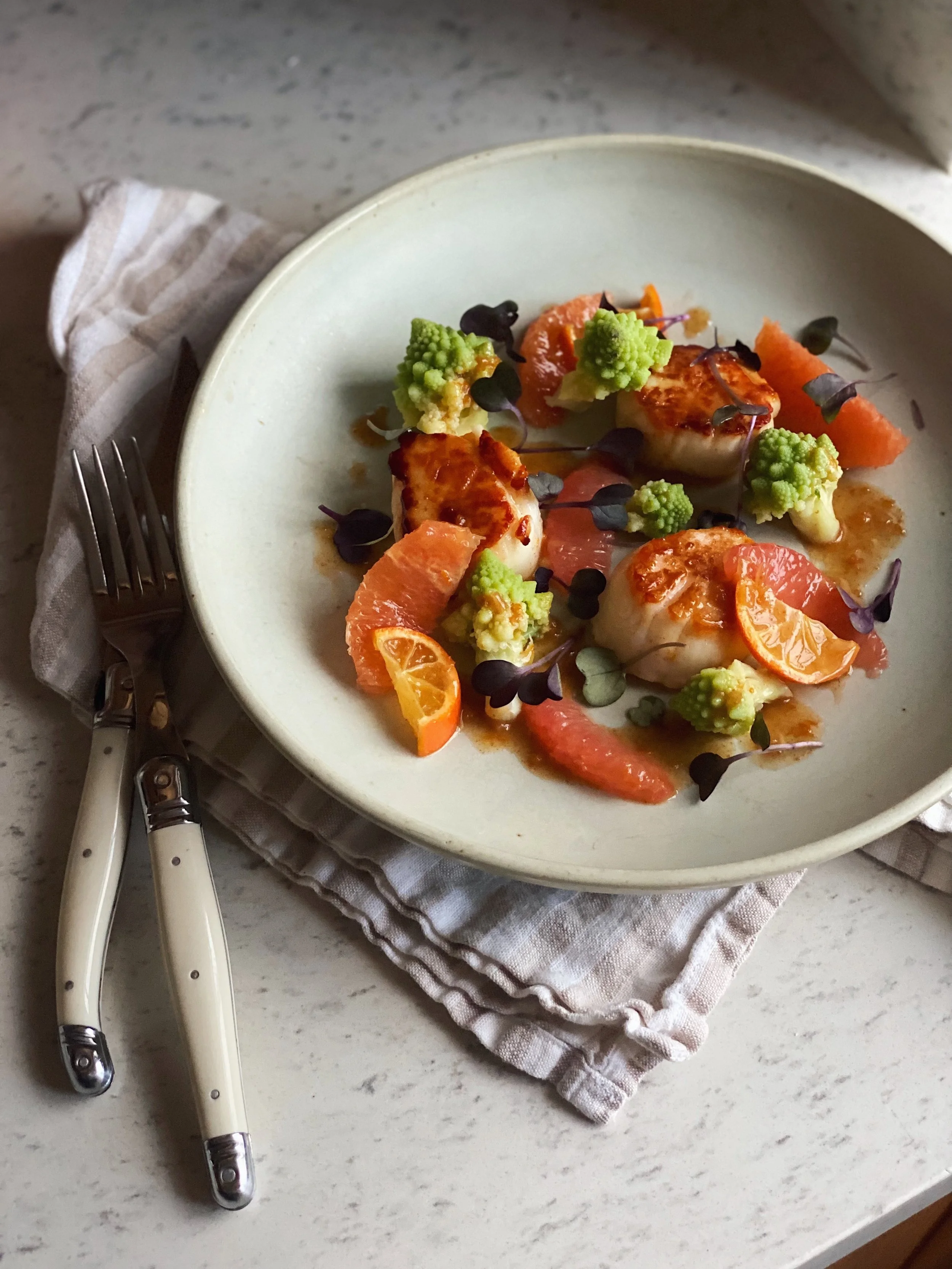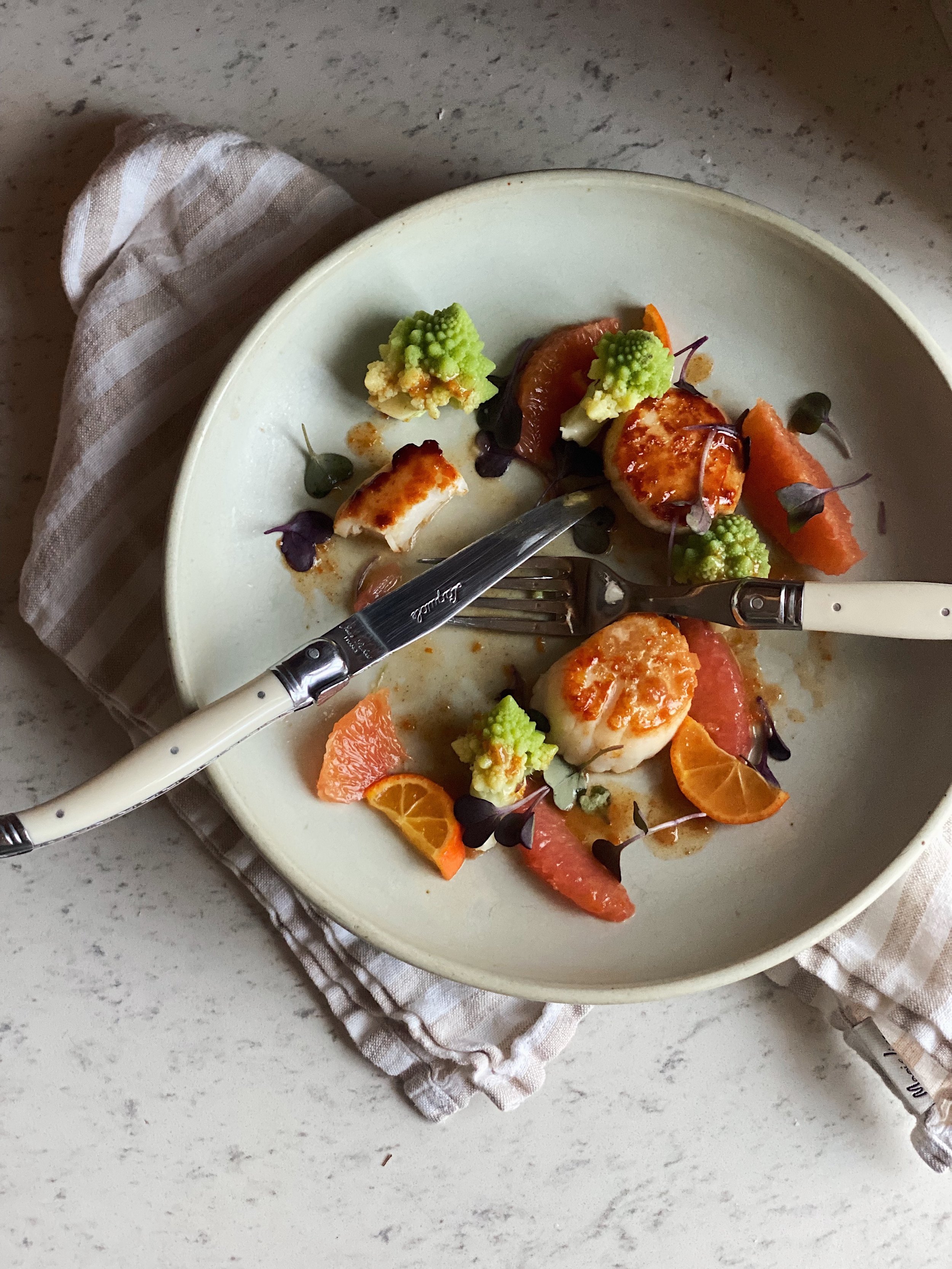Seared Scallops with Warm Brown Butter Citrus Vinaigrette
This is one of my absolute favorite recipes we made in culinary school, so I adapted it for you to make at home! This would be absolutely perfect for any special occasion (I’m looking at you, Valentine’s Day).
This recipe includes a fool-proof way for cooking scallops (with more tips in the notes section), so if you don’t want to make the full dish, you can follow this cooking method method for any scallop dish. Other ideas for serving scallops are served atop a bed of risotto, with a salad, etc. I hope you give it a try!
Serves 4.
INGREDIENTS
For the scallops:
12 large sea scallops*
Kosher salt
2 Tbsp clarified butter or ghee*
For the warm brown butter citrus vinaigrette:
3/4 cup fresh orange juice (from ~3 oranges)
1/4 cup fresh grapefruit juice (from ~1 grapefruit)
1/4 cup sherry vinegar
2 Tbsp minced shallot or red onion
2 tsp grated citrus zest (I like to use a combination or orange and grapefruit zest)
1.5 tsp dijon mustard
8 Tbsp unsalted butter
2 Tbsp extra virgin olive oil
Kosher salt
To finish the dish:
1 head romanesco or cauliflower, cut into bite size florets and blanched until tender
Segments from 2 grapefruit
Segments from 2 oranges
6-8 kumquats, left whole and thinly sliced (optional)
Micro greens or watercress (optional)
Maldon salt
METHOD
Season the scallops
Remove the scallops from the refrigerator and pat dry.
Season all over with kosher salt and set aside on the counter. This will allow the scallops to temper and the salt to permeate the scallops. In the mean-time, make the vinaigrette.
Make the warm brown butter citrus vinaigrette:
Add the citrus juice, sherry vinegar, shallot and zest into a small saucepan. Bring up to a simmer over a medium flame and cook until the liquid has reduced to a total of 1/2 cup. This will take 10-15 minutes.
Take the saucepan off the heat and whisk in the dijon mustard. Set aside, keeping the mixture in the same saucepan to stay warm.
Brown your butter — add to a small skillet over medium-high heat and allow the butter to bubble, stirring constantly with a spatula, until the milk solids turn a light amber color and the butter begins to smell nutty. The butter will spatter a bit as it cooks and that’s totally normal – that’s the water in the butter cooking out. Once the milk solids in the butter turn amber in color, immediately transfer to a glass pyrex measuring cup or a bowl to stop the cooking process. It can go from perfectly brown to burnt really fast.
Add the olive oil to the browned butter, then very slowly stream the butter/oil mixture into the citrus/dijon mixture, whisking constantly. Slowly adding in the butter/oil will allow for a thick, emulsified mixture.
Add kosher salt, to taste.
You can make this vinaigrette up to a few hours ahead, just whisk over low heat to warm it up before serving.
Cook the scallops (see notes for a bunch of tips):
Pat the seasoned scallops dry and heat a large non-stick skillet over medium-high heat. Once hot, add the clarified butter or ghee and swirl around in the pan.
Add in the scallops, making sure to not overcrowd them (you may need to cook them in batches depending on the size of your pan).
Cook on the first side for 3-4 minutes, or until the scallops are super brown and crusty on the bottom and are becoming opaque 3/4 of the way up. Adjust the heat if the scallops are taking on too much color.
Flip the scallops and allow to cook on the other side for 20-30 seconds, then pull off the heat.
Plate the dish:
Arrange three scallops on each plate and add the romanesco florets and citrus segments throughout.
Generously spoon over the warm brown butter vinaigrette atop everything.
Finish the dish with the micro greens (optional) and a pinch of maldon salt. Enjoy!
NOTES
Tips for cooking scallops & getting really nice golden brown crust:
It’s important to look for dry scallops (also referred to as“day boat,” “diver” scallops), not wet scallops. Wet scallops are caught, then immediately transferred to soak in a solution that helps preserve them. Often times, they are frozen. Dry scallops are not treated in this way. It’s important to choose those dry scallops if you can because they will brown very nicely for you, whereas wet scallops retain that solution they were packed in and therefore won’t brown nicely.
You want to salt the scallops ahead of time to properly season them throughout. It’s important to then pat them dry before cooking because we want to avoid excess moisture being drawn out by the salt (moisture will inhibit browning).
Make sue you use a high smoke point fat to cook your scallops. I prefer to use clarified butter or ghee for the flavor. However if you don’t have those, you can use any neutral oil with a high smoke point (i.e. avocado oil, canola oil, etc.). Just avoid using something like regular butter because the milk solids will burn when you cook the scallops.
The idea is to cook the scallops for 90% of the time on the first side or the “presentation”side (AKA the side that will be visible when you serve it). This allows you to get a really nice crust on that one side vs. a mediocre brown if you were to equally split the cooking time per side.
You don’t want to overcook your scallops, so once you get a nice brown first side, your scallop will be mostly cooked, so you just want to barely cook it (20-30 seconds) on the second side. You’ll notice when you cook your scallop on the first side, that the scallop meat will begin to turn opqaque ~2/3 - 3/4 the way up the scallop. This is what you are looking for.



